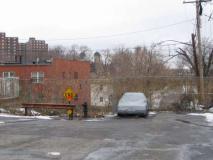So you’re wandering about in the Bronx wilds east of Bronx Park, where you’ve just photographed an American replica of the shrine at Lourdes (more about that on a future FNY page), you’ve gone past the gas stations, Popeyes and Wendys of Boston Road and seen where Williamsbridge Road gets its mojo, when all of a sudden you’re in a land of curving roads lined with antebellum (or is it postbellum, or cerebellum) mansions. Aluminum-sided as they are, they harken back to a time when the Bronx wasn’t quite as urban as it is today.
 It’s not Brigadoon, it’s Bronxwood Park, consisting of a pair of roads (North and South Oak Drives) between Wallace and Cruger Avenues just north of Burke Avenue and close to the White Plains Road el.
It’s not Brigadoon, it’s Bronxwood Park, consisting of a pair of roads (North and South Oak Drives) between Wallace and Cruger Avenues just north of Burke Avenue and close to the White Plains Road el.
In the late 1880s and early 1890s John T. Adee, who owned considerable property in the northeast Bronx, sponsored a new real estate development here and the curving roads, lined with mainly chestnut and oak trees, were laid out. To this day their curving routes are quite a contrast to the rest of the Bronx grid.
Just west of Barnes Avenue North Oak Drive splits into two, with the southern section becoming South Oak Drive. Issuing north from North Oak Drive is a dead end unhinted at on most Bronx maps, North Chestnut Drive (left). On the corner is a massive, concrete-clad house that looks as if it might survive a war or two.
At North Oak and Wallace Avenue you come upon a huge porched house. Many homes with porches are positioned at the crests of hills and this is no exception. Indeed the hill on Wallace is so steep that the city decided to not bother running a road downhill. Step streets are usually provided in cases like this, but not even here.
Homes in Bronxwood Park number many original multiroom buildings that typically housed two families. Of course they have long since been aluminum-sided because that is the convention in a city where practicality Trumps esthetics. However, there’s enough individuality, like the stone porch and old-fashioned gate, to remind you that this was someplace special years ago.
LEFT: North Oak Drive curves to meet Holland Avenue, named according to the great Bronx historian John McNamara for a NYC mayor from 1747-1757, not, as I thought, for Clifford Holland, the engineer of the Holland Tunnel. RIGHT: The house on South Oak Drive must have been something to see before all of that siding was applied.
LEFT: Developers must be greedily eyeing this large plot with a gazeboed yard. Such an expanse of green is considered wasteful by developers, politicians, and real estate doyennes. RIGHT: Traveling east on South Oak, we find its junction with North Oak again.
1/8/08















1 comment
My son and I spent his first 6 years living nearby of here. On many nice days days walking and learning how to ride our bikes in the beautiful park that is behind this neighborhood. Perhaps one of my favorites in the borough named for Jonas.
Comments are closed.